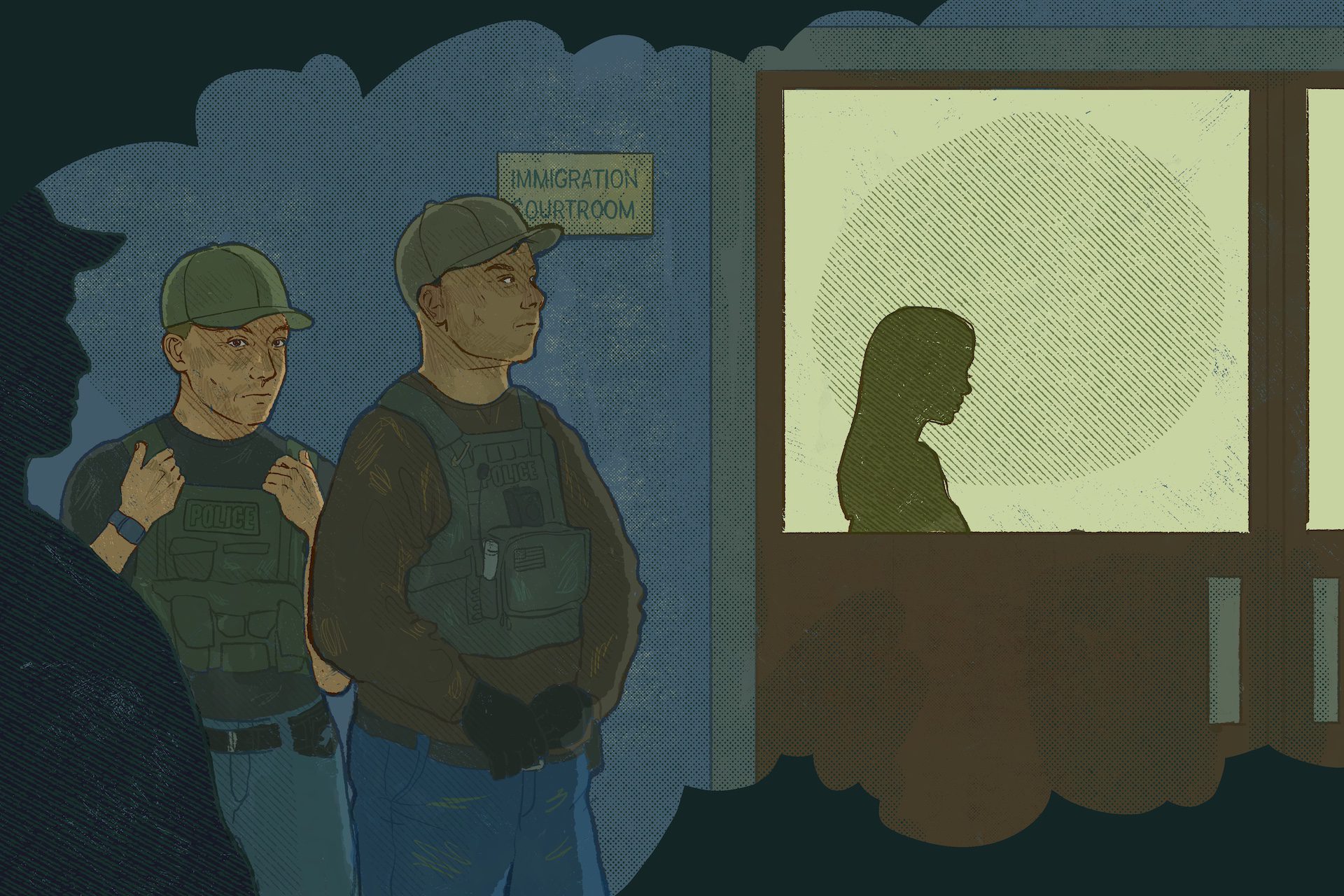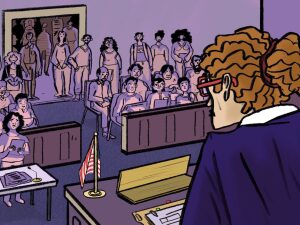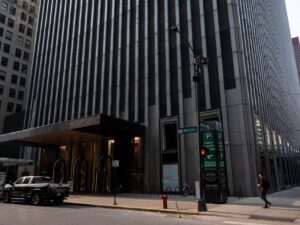 Illustration by Elena Delzer
Illustration by Elena Delzer From stricter federal policies to judicial firings, how Donald Trump and the Department of Justice are using immigration courts to carry out his deportation efforts.
Attorney Omar Abuzir was explaining to his client what had just failed in court and the hurdles that had recently sprung up in the immigration court system.
He had the facts to back up his case, pointing to a stack of documents perched on his lap in a quiet waiting room, and the judge appeared sympathetic to his client’s case, he said.
With those in hand, he once would have won the case or been able to “cut a deal” with the prosecutor, he said.
News that puts power under the spotlight and communities at the center.
Sign up for our free newsletter and get updates twice a week.
But that is no longer what happens, said the veteran immigration attorney: “[The prosecutors] are not agreeing to anything,” he explained.
The prosecutors’ hard-line stances are only a small part of the thunderstorm of rules and policies that the Trump administration has showered steadily upon the nation’s 70 immigration courts since January.
Trump’s first term in the White House brought “get-tough” changes to immigration courts. Now, in the first seven months of his second term, old protections for immigrants have been ripped up as new, restrictive rules have been rolled out, and judicial officers are being fired.
“There has just been an onslaught of change from day one of this administration,” said Shannon Shepherd, a veteran immigration lawyer in Chicago. She has, especially, been struck by how the government’s court actions “seem harsher and crueler.”
Profound Changes
The White House strategy has been to sweep more immigrants into the courts and then speed them through the system, while spinning a broader and less forgiving enforcement aimed at the estimated 11 million undocumented immigrants in the U.S.
Some of the changes sought by the government have included:
- Wiping out free legal counsel for an estimated 26,000 unaccompanied minors;
- Allowing immigration court judges to decide whether immigrants are eligible for asylum without holding a hearing; and
- Closing three ombudsman offices that monitor the immigration courts, detention facilities and law enforcement’s treatment of immigrants.
The result has been a 3.4 million-case backlog nationally as of June, more than twice the backlog for all of 2021. Similarly, Chicago’s Immigration Court had over 222,000 backlogged cases, five times the number in 2020.
Outside of the courts, Immigration and Customs Enforcement (ICE) arrests have grown nationally by 124% and 98% in Illinois in June, according to an analysis by the New York Times. That same month, 57,861 immigrants were held in detention centers across the U.S.— the highest number on record since 2019. According to Reuters, detention facilities have a capacity of 41,500.

The courtroom policy changes and expedited removals have triggered months-long lawsuits by immigrant and human rights groups.
The Executive Office of Immigrant Review (EOIR), the agency that oversees the nation’s immigration courts, declined to comment on the staffing cuts and policy changes in the courts.
Meanwhile, the Trump administration has set a quota to arrest 3,000 immigrants daily and expanded the expedited removal for people who arrived in the U.S. within the last two years. Previously, immigrants could only be removed if they had been in the country for 14 days and apprehended within 100 miles of a U.S. border.
In these instances, a court hearing is not required unless immigrants explicitly cite fears of where they might be deported, a fact most immigrants do not know, attorneys say.
Amid the sweeping enforcement practices, the EOIR lifted a ban on enforcement actions in or near immigration courts. In recent months, ICE agents began making arrests after cases were dismissed in Chicago and several other courtrooms nationwide.
On multiple occasions, Borderless reporters witnessed federal officers detain immigrants immediately after their cases were dismissed.
This process caught a long-time immigration lawyer off guard. The attorney asked to remain anonymous out of fear of retaliation.
Read More of Our Coverage
After his client’s case was dismissed, the attorney thought his client, an immigrant from China, had won his freedom. But as the lawyer exited the courtroom and turned back, he was stunned to see his client being led away by ICE agents.
He has not spoken up publicly since the incident, he said, outside a courtroom in May.
“I don’t want to make trouble. This court has ways of getting back at you,” he explained.
Cracking Down on the Courts
Another arm of the government’s drive to round up undocumented immigrants has been a campaign to change what happens in the courts via new rules or sweeping staff changes.
Since January, EOIR has shaken up the ranks of immigration court judges by firing the agency’s four top officials, who oversee the nation’s immigration court system. Soon after, the agency fired dozens of judges, of whom 13 were in training and ready to be assigned.
The judges have since filed a lawsuit against the government for failing to give prior notice. According to reports, the Department of Justice recently fired 17 judges, including three from Chicago. In addition, dozens more judges have resigned or taken early retirement, according to AILA and reports.
Former judges and legal experts immediately reacted to the staff cutbacks by pointing out the irony of staff trimming when the court backlog was expected to grow.
“It’s outrageous and against the public interest that at a time when…Congress has authorized 800 immigration judges, we are firing large numbers of immigration judges without cause,” Matt Biggs, president of the International Federation of Professional and Technical Engineers (IFPTE), a union representing immigration judges, told NPR.
“This is hypocritical — you can’t enforce immigration laws when you fire the enforcers.”
The acting director of EOIR explained the agency’s new thinking in a lengthy memo, arguing it aimed to “recommit to its core value and the rule of law.”
Last month, U.S. Senators Elizabeth Warren (D-MA) and Edward Markey (D-MA) wrote to EOIR, challenging the firings of some of the judges in training, saying the government appeared intent on politicizing the court. They noted that the probationary judges who were not removed have worked in immigration enforcement.
One of those judges who stepped down said they would often take time during a hearing with immigrants, who did not have lawyers, and ask detailed questions that essentially filled in the blanks about their cases — information that immigrants might not realize mattered to their fates.
The judge asked to remain anonymous.
Read More of Our Coverage
As the changes in the court grew in the early weeks of the Trump administration, the judge began to weigh their options. The judge liked the idea of carrying out justice for the immigrants on their caseload.
But the judge’s dismay grew daily.
“It was the general meanness of the system,” the judge said.
At the same time, the judge felt that their job was at risk because the government had indicated that it would end a layer of job protection, suddenly turning judges into at-will employees. Not taking the government’s tough line on immigrants in every case put his job in danger, the judge said.
“There is a concern that if you don’t make a decision in the way the wind is blowing, a way that would please the administration, that your job would not be safe,” the judge explained.
Earlier this year, Chad Mizelle, the chief of staff of the Department of Justice, claimed immigration court judges “exercised immense power for far too long.” Mizelle noted that the Department was restoring “constitutional accountability so that Executive Branch officials answer to the President and to the people.”
AILA issued a stern condemnation in response to the onslaught of changes, arguing that the new policies would “transform judges and the entire court system into arms of the enforcement system rather than neutral, balanced instruments of justice.”
In June, AILA sent out a report containing an EOIR email to judges, describing steps they should take “to meet the demands of the increased workload.” In one of them, EOIR ordered judges to make oral decisions immediately after hearing testimony and lawyers’ arguments.
The AILA argued that the EOIR directive “appears to violate the regulations” and urged lawyers to heed its points in their arguments and enter them into the courtroom record.
Similarly, the New York City Bar recently called the Trump administration’s actions “a radical dismantling of the U.S. immigration system.” The organization urged lawyers in New York and nationwide “to do what they can…to uphold and secure individual rights.”
Whether or not they were responding to the government’s pressures, the nation’s immigration courts have become tougher places for immigrants to win their cases.
The rate of judges’ denials in asylum cases hit 79% nationally in April, up from 51 % at the same time last year and the highest in 25 years.
The latest figures show that Chicago’s Immigration Court judges granted asylum to just over 50% of the cases before them as of May.
Amid the steady flow of new courtroom rules — and after weeks of debating what to do — the veteran immigration court judge quit. The judge wanted to bow out quietly, only announcing their departure to fellow judges and court staff.
“It really became very obvious to me that, as much as I loved my job. It was no longer a good fit for me as a person,” the judge said.
Then added in a lowered voice, “I miss it.”
Fear and Uncertainty
Almost as soon as Trump announced plans to round up thousands of undocumented immigrants daily, attorneys say fears began spreading.
“This was such an onslaught of change from the administration,” attorney Shepherd said. These changes have brought on “widespread fear and panic.”
Some calls she received surprised her. They were from people with legal status, who had no reason to be afraid. “And I’ve never seen that before,” she said.
This wasn’t a unique experience.
“Everyone seems to be afraid of being detained, and there’s good reason for them to fear that,” says Martin Perez, attorney with an office in Chicago’s Brighton Park. Seeing what is taking place in immigrant court, Perez has decided to be especially cautious about predicting what may happen in court for his clients.
As an example of the changes, he points to one of his clients, who has lived in the U.S. for 30 years, has four children, and is facing a bond hearing to get out of detention. “In years past, somebody like that would have been released,” said Perez.
While the administration says its goal is to rid the U.S. of immigrants with criminal records, Perez’s client fits the more common profile of those in detention. About 71% of those held in ICE’s detention facilities in June had no criminal convictions, according to the TRAC system at Syracuse University.
Like many immigration attorneys, Perez said he meets “a lot of people who can’t afford a lawyer” or find a free one. He explained that the problem is compounded by the demand for free services and immigrants’ uncertainty about whom to trust.
Figures show that only one out of four immigrants in Chicago’s immigration court in 2025 had a lawyer, compared to just over one out of three nationally.
Claire Doutre, who was a lawyer in immigration court in Houston before moving to Chicago, recited the changes in court she has witnessed lately.
Prosecutors rarely bargain. Many more clients are detained. And when immigrants are detained, they are sometimes shifted from prison to prison outside of Illinois. (Since 2021, Illinois has banned detention facilities from holding immigrants.)

Once people are detained, families quickly lose contact and go days before locating their family members. Some immigrants are also sent to Texas or Louisiana, facing tougher judges. When they are sent far away, it is hard for Doutre to see them and to discuss their cases. She has to rely on phone or video calls, which makes her worry if everything they say is confidential.
“On top of not providing attorneys, the system is not friendly at all,” Doutre said. “When you enter the court, not everyone will speak your language. You are supposed to know everything.”
“I understand that everyone is just a wheel in the system, and it is hard for people to access the due process they should have.”
Lost and Alone
Inside Chicago’s immigration court for a 10:30 a.m. hearing, Tania recently sat alone waiting for her turn.
The young woman from Ecuador speaks limited English and Kichwa, a derivative of Quechua, the language spoken by Indigenous people across the Andes.
She sat all morning in the waiting area outside the courtroom and waited until late afternoon, when nearly all the judges and staff had gone. She sat alone and frightened.
Finally, she turned to a young man from Rogers Park. He had come to court to see how the court process worked because he wanted to get involved in helping immigrants in his neighborhood. He didn’t speak Spanish but quickly found someone who did.
That led her to enter a silent courtroom nearby—not the one she was supposed to attend—where a judge was still on hand. The judge checked Tania’s record and then informed her that her removal from the U.S. had been ordered in the court where she was supposed to appear in the morning.
She looked confused.
From there, she was led to a clerk’s office, where a clerk said that such mishaps sometimes occur and that Tania had to fill out a form for a new trial. Tania stared at the several-page form, written in Spanish, and wondered what to do.
Just then, an attorney from the Help Desk provided by the National Immigrant Justice Center (NIJC) had stepped into a line outside the clerk’s office with some immigrants he was assisting. Hearing about Tania’s dilemma, he promised to help her once he finished his current case. He added that he had helped others with similar problems before.
The woman from Ecuador waited outside his office as a hush fell over the usually busy courtroom area. As she waited, she clutched the form in one hand: her face frozen in the look that she had all day, the look of someone lost in a rapidly spinning wheel.
Stephen Franklin is a contributing writer for Borderless Magazine.



